Ocular dominance columns in V1 are more susceptible than associated callosal patches to imbalance of eye input during precritical and critical periods
- PMID: 33683706
- PMCID: PMC8165009
- DOI: 10.1002/cne.25134
Ocular dominance columns in V1 are more susceptible than associated callosal patches to imbalance of eye input during precritical and critical periods
Erratum in
-
Erratum.J Comp Neurol. 2021 Dec;529(17):3845-3863. doi: 10.1002/cne.25222. Epub 2021 Aug 30. J Comp Neurol. 2021. PMID: 34463057 No abstract available.
Abstract
In Long Evans rats, ocular dominance columns (ODCs) in V1 overlap with patches of callosal connections. Using anatomical tracers, we found that ODCs and callosal patches are present at postnatal day 10 (P10), several days before eye opening, and about 10 days before the activation of the critical period for ocular dominance plasticity (~P20). In rats monocularly enucleated at P10 and perfused ~P20, ODCs ipsilateral to the remaining eye desegregated, indicating that rat ODCs are highly susceptible to monocular enucleation during a precritical period. Monocular enucleation during the critical period exerted significant, although smaller, effects. Monocular eye lid suture during the critical period led to a significant expansion of the ipsilateral projection from the nondeprived eye, whereas the contralateral projection invaded into, and intermixed with, ipsilateral ODCs innervated by the deprived eye. We propose that this intermixing allows callosal connections to contribute to the effects of monocular deprivation assessed in the hemisphere ipsilateral to the nondeprived eye. The ipsilateral and contralateral projections from the deprived eye did not undergo significant shrinkage. In contrast, we found that callosal patches are less susceptible to imbalance of eye input. In rats monocularly enucleated during either the precritical or critical periods, callosal patches were maintained in the hemisphere ipsilateral to the remaining eye, but desegregated in the hemisphere ipsilateral to the enucleated orbit. Callosal patches were maintained in rats binocularly enucleated at P10 or later. Similarly, monocular deprivation during the critical period had no significant effect on callosal patches in either hemisphere.
Keywords: Long Evans rats; RRID:RGD 68073; columnar organization; desegregation; eye-specific domains; interhemispheric connections; monocular deprivation; monocular enucleation; primary visual cortex.
© 2021 Wiley Periodicals LLC.
Conflict of interest statement
CONFLICT OF INTEREST
Authors declare no conflict of interest
Figures
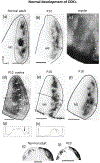
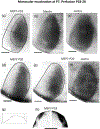
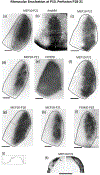
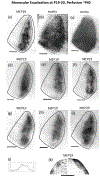
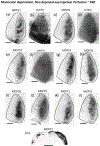
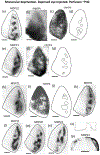
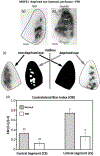
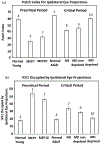
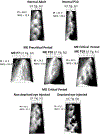
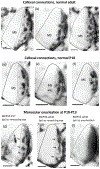
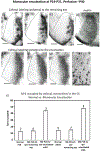
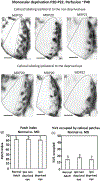


Similar articles
-
Development of ocular dominance columns across rodents and other species: revisiting the concept of critical period plasticity.Front Neural Circuits. 2024 Jul 5;18:1402700. doi: 10.3389/fncir.2024.1402700. eCollection 2024. Front Neural Circuits. 2024. PMID: 39036421 Free PMC article. Review.
-
Influence of ocular dominance columns and patchy callosal connections on binocularity in lateral striate cortex: Long Evans versus albino rats.J Comp Neurol. 2020 Mar 1;528(4):650-663. doi: 10.1002/cne.24786. Epub 2019 Oct 18. J Comp Neurol. 2020. PMID: 31606892 Free PMC article.
-
Effect of monocular blockade of retinal activity on the development of visual callosal connections in the rat.Biol Res. 1995;28(3):219-26. Biol Res. 1995. PMID: 9251752
-
Development of visual callosal connections in neonatally enucleated rats.J Comp Neurol. 1987 Jun 15;260(3):321-48. doi: 10.1002/cne.902600302. J Comp Neurol. 1987. PMID: 3597836
-
The corpus callosum and the visual cortex: plasticity is a game for two.Neural Plast. 2012;2012:838672. doi: 10.1155/2012/838672. Epub 2012 Jun 21. Neural Plast. 2012. PMID: 22792494 Free PMC article. Review.
Cited by
-
Development of ocular dominance columns across rodents and other species: revisiting the concept of critical period plasticity.Front Neural Circuits. 2024 Jul 5;18:1402700. doi: 10.3389/fncir.2024.1402700. eCollection 2024. Front Neural Circuits. 2024. PMID: 39036421 Free PMC article. Review.
-
A column-like organization for ocular dominance in mouse visual cortex.Nat Commun. 2025 Feb 25;16(1):1926. doi: 10.1038/s41467-025-56780-3. Nat Commun. 2025. PMID: 40000624 Free PMC article.
-
Overall patterns of eye-specific retino-geniculo-cortical projections to layers III, IV, and VI in primary visual cortex of the greater galago (Otolemur crassicudatus), and correlation with cytochrome oxidase blobs.Vis Neurosci. 2022 Nov 2;39:E007. doi: 10.1017/S0952523822000062. Vis Neurosci. 2022. PMID: 36321413 Free PMC article.
-
Blockade of retinal or cortical activity does not prevent the development of callosal patches normally associated with ocular dominance columns in primary visual cortex.Vis Neurosci. 2021 Aug 23;38:E012. doi: 10.1017/S0952523821000110. Vis Neurosci. 2021. PMID: 35502808 Free PMC article.
References
-
- Aggoun-Zouaoui D, Kiper DC, & Innocenti GM (1996). Growth of callosal terminal arbors in primary visual areas of the cat. European Journal of Neuroscience, 8(6), 1132–1148. - PubMed
-
- Boyd J, & Matsubara J (1994). Tangential organization of callosal connectivity in the cat’s visual cortex. The Journal of Comparative Neurology, 347(2), 197–210. - PubMed
Publication types
MeSH terms
Grants and funding
LinkOut - more resources
Full Text Sources
Other Literature Sources

